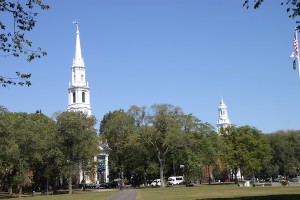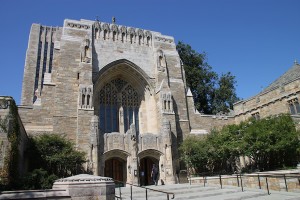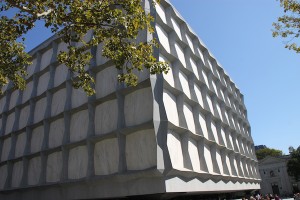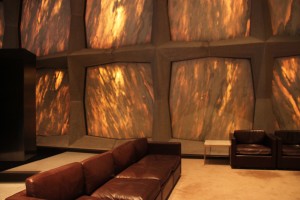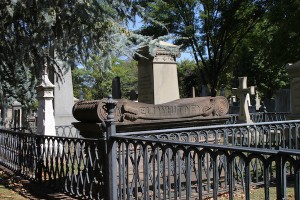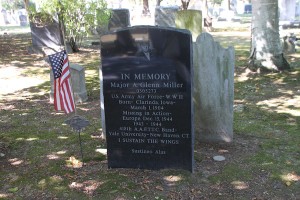I read this week that Yale University is buying a huge collection of photos, mostly focused on Abraham Lincoln and the Civil War era.
To be more precise, it is Yale’s Beinecke Rare Book & Manuscript Library and Yale University Art Gallery that are acquiring the collection, which includes 57,000 prints, thousands of books and other printed materials. The seller is the Meserve-Kunhardt Foundation.
I had not been aware that such a collection existed, but I can imagine it is of incredible value, the more so as the years go by.
However, I have seen the Beinecke Library. The exterior left me cold, but I was converted on seeing the inside (more below).
Last fall (2014), my sister and I joined the free walking tour of the campus that Yale makes available to visitors almost daily.
The guides for these outings are Yale students, and the excursions open with a few factoids about New Haven, Conn., Yale’s hometown.
Our enthusiastic Yalie told us New Haven was America’s first planned city and home to the first hamburger and the first Frisbee.
I recognized all those claims because I had researched each one when writing the New Haven posting that appears at this Web site (https://besttripchoices.com/us-cities/new-haven-connecticut/).
The first claim to fame appears in my list of five trivia items that lead off the posting, as follows: “Founded in 1638, New Haven was America’s first planned city, laid out in nine squares.”
I had many more viable New Haven trivia items than the five I needed, so the information about the first hamburger (cooked and sold at Louis’ Lunch in 1900) appears farther down in the posting.
As to the Frisbee, I could not satisfactorily confirm that it was invented in New Haven, but I could confirm that it was named (with adapted spelling) for the Frisbie Pie Co., whose tins Yale students tossed for fun. That does not appear at the posting — there was not room for everything.
Yale campus
The university counts 11,500 students in a city of around 125,000, our guide said.
But the campus is New Haven’s centerpiece, wrapped around the city’s historic central common. Indeed, the town green was once a graveyard and some of the bodies are still there.
The campus is distinguished by a large number of buildings that are reminiscent of those at Cambridge and Oxford in England. The chief architect, active in the early 20th century, was J.G. Rogers, who created the American Collegiate Gothic style so evident at Yale. Complementing the design details, he artificially aged buildings by using acid and fire, leaving statue niches empty and cracking some windows.
Our tour included two libraries. The first was a Rogers design, the 1930 Sterling Memorial Library, Yale’s largest library and home to 4 million books.
It looks like a cathedral inside. At its Web site, Yale points to the library’s cloisters, clerestory windows, side chapels, “a circulation desk altar” and 3,300 stained-glass windows.
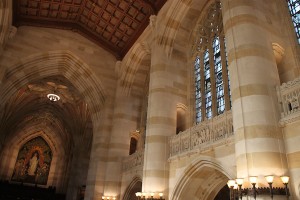
Interior of the Sterling Memorial Library, designed with many features imitative of a European Gothic cathedral.
Whereas the exterior of the 1961-1963 Beinecke Library just looks nondescript modern (to my eyes).
The good stuff is on the inside. Given this facility is devoted to the preservation of rare and historically important materials, the lighting is dim, and what sunlight reaches the interior is filtered through, not windows, but Vermont marble. The effect is striking.
Further, the interior public spaces encircle an enclosed core that, our guide said, accommodates 180,000 books. Visitors can see into the space but wouldn’t want to enter — the oxygen levels are reduced in the core to protect the books.
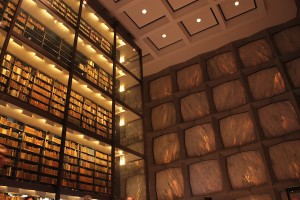
Interior of the Beinecke Library, with some of the protected books — sheltered in an interior reduced-oxygen space — visible here. Marble walls are visible at right.
Another 620,000 books are stored and protected at a basement level that we did not see. Our guide said the collections, used by researchers, include declassified CIA documents. Interesting stuff.
This fall, the newly purchased collection of Civil War photographs and books will be divided between the Beinecke Library and the university’s art gallery.
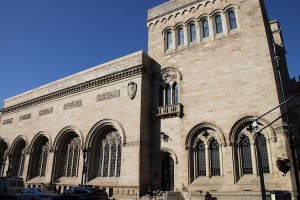
The Yale University Art Gallery, co-purchaser of a vast collection of Lincoln and Civil War memorabilia.
Our tour did not include the art gallery, and — given the glorious sunny day of our visit — my sister and I chose not to enter another building.
One of our self-directed diversions was the Grove Street Cemetery, which but for the tombstones was an idyllic city park brightened by autumn colors. It was America’s first chartered burial ground (1797).
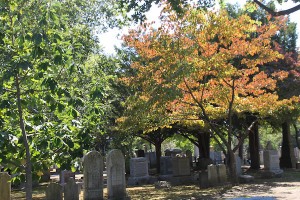
The park-like Grove Street Cemetery in New Haven, on an autumn day. It was America’s first chartered burial ground (1797).
A map at the cemetery entry lets visitors find the stones marking the graves of several well-known people, including Charles Goodyear, Noah Webster and Eli Whitney. Also, a memorial to bandleader Glenn Miller, an Iowa native — like my sis and me — whose plane disappeared during World War II.
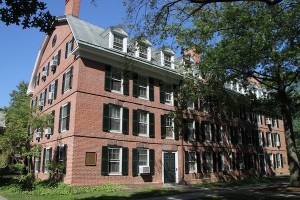
Finally, as a matter of interest, this is Connecticut Hall, Yale University’s oldest building (1750-1752), constructed before much of the campus was designed to look so much like Cambridge and Oxford in England.
To repeat myself, for more about New Haven, Conn., see the following, under the headline: Yale’s hometown https://besttripchoices.com/us-cities/new-haven-connecticut/
This blog and photos are by Nadine Godwin, BestTripChoices.com editorial director and contributor to the trade newspaper, Travel Weekly. She also is the author of “Travia: The Ultimate Book of Travel Trivia.”

